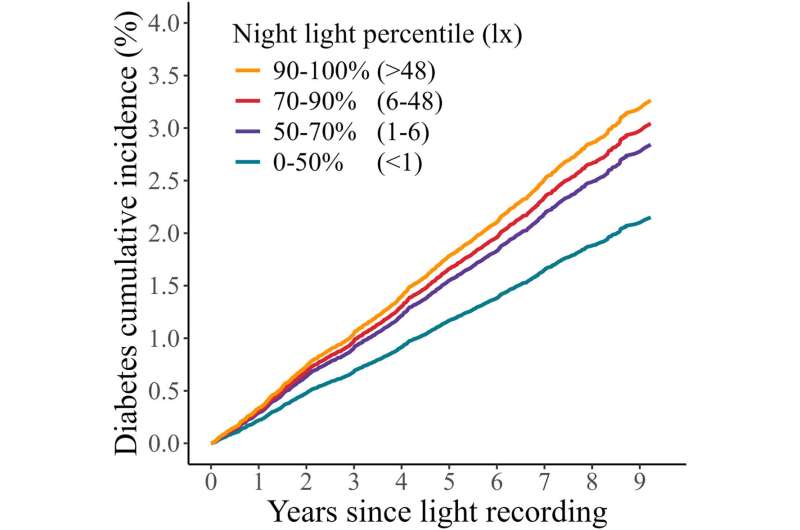This article has been reviewed according to Science X's editorial process and policies. Editors have highlighted the following attributes while ensuring the content's credibility:
fact-checked
trusted source
proofread
Fighting the late-night bright light could reduce risk of diabetes

Avoiding bright light at night could be a simple way to reduce your risk of diabetes, a Flinders University study shows.
The study, published in The Lancet Regional Health—Europe, reveals the compelling relationship between exposure to light and the risk of developing type 2 diabetes.
Type 2 (acquired) diabetes is a chronic condition that affects how the body uses insulin. It develops over many years, is difficult to treat and is usually related to lifestyle factors such as inactivity and obesity.
"We found that exposure to brighter light at night was associated with a higher risk of developing type 2 diabetes," says senior author Associate Professor Andrew Phillips from the College of Medicine and Public Health.
In the large modeling study, the research team investigated whether personal light exposure patterns predicted the risk of diabetes using data from approximately 85,000 people and around 13 million hours of light sensor data.
The participants—who did not have type 2 diabetes—wore devices on their wrist for one week to track their light levels throughout the day and night.
They were then tracked over the following nine years to observe whether they went on to develop type 2 diabetes.
"Light exposure at night can disrupt our circadian rhythms, leading to changes in insulin secretion and glucose metabolism," he says.
"Changes in insulin secretion and glucose metabolism caused by disrupted circadian rhythms affect the body's ability to regulate blood sugar levels, which can ultimately lead to the development of type 2 diabetes."
Having more exposure to light at night (between 12:30am and 6:00am) was linked to a higher risk of developing type 2 diabetes, and this was true regardless of how much light people were exposed to during the day.
The research accounted for other factors associated with type 2 diabetes, such as lifestyle habits, sleep patterns, shift work, diet, and mental health.
Even after taking these factors into account, the findings showed that getting more light at night was still a strong predictor of developing diabetes.
"The results showed that exposure to brighter light at night is associated with a higher risk of developing diabetes, with a dose-dependent relationship between light exposure and risk," says Associate Professor Phillips.
"Our findings suggest that reducing your light exposure at night and maintaining a dark environment may be an easy and cheap way to prevent or delay the development of diabetes," he adds.
More information: Daniel P. Windred et al, Personal light exposure patterns and incidence of type 2 diabetes: analysis of 13 million hours of light sensor data and 670,000 person-years of prospective observation, The Lancet Regional Health - Europe (2024). DOI: 10.1016/j.lanepe.2024.100943




















